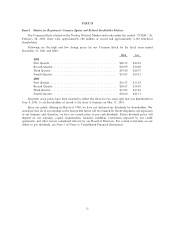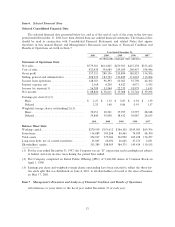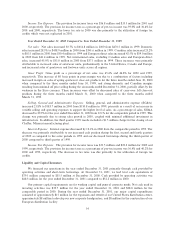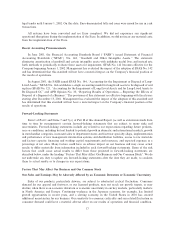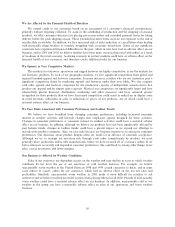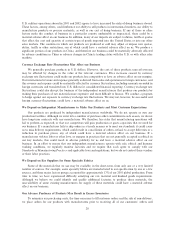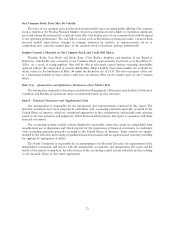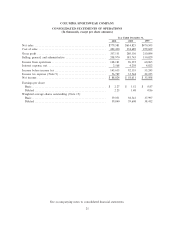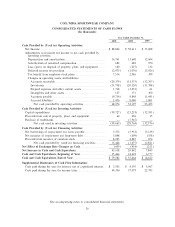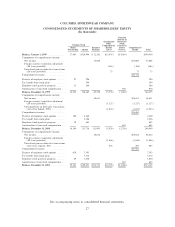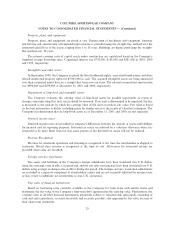Columbia Sportswear 2001 Annual Report Download - page 25
Download and view the complete annual report
Please find page 25 of the 2001 Columbia Sportswear annual report below. You can navigate through the pages in the report by either clicking on the pages listed below, or by using the keyword search tool below to find specific information within the annual report.We May Not Be Able to Implement Our Growth Strategy or Manage Growth Successfully
We face many challenges in implementing our growth strategies. For example, our expansion into
international markets involves countries where we have little sales or distribution experience and where our
brand is not yet widely known. Expanding our product categories involves, among other things, gaining
experience with new products, winning consumer acceptance, and establishing intellectual property rights.
Increasing sales to department stores, and improving the sales productivity for our customers, will each depend
on various factors, including strength of our brand name, competitive conditions, our ability to manage
increased sales and Ñxture expansion, the availability of desirable locations and the negotiation of terms with
retailers. Future terms with customers may be less favorable to us than those we now operate under. Large
retailers in particular increasingly seek to transfer certain costs of business to their vendors, such as the cost of
lost proÑts from product price markdowns. To implement our business strategy, we need to manage growth
eÅectively. We need to continue to change certain aspects of our business, to maintain and enhance our
information systems and operations to respond to increased demand and to attract, retain and manage
qualiÑed personnel. Growth could place an increasing strain on management, Ñnancial, product design,
marketing, distribution and other resources, and we could experience operating diÇculties. For example, in
recent years, we have undertaken a number of new initiatives that require signiÑcant management attention
and corporate resources, including the development or expansion of distribution facilities on two continents
and the acquisition, rejuvenation and extension of the Sorel» brand. Such growth involves many risks and
uncertainties, and if we are unable to manage it eÅectively we may not achieve our objectives and there could
be a material adverse aÅect on our business.
Our Success Depends on Our Distribution Facilities and Systems
Our ability to meet customer expectations, manage inventory, complete sales and achieve objectives for
operating eÇciencies depends on the proper operation of our existing distribution facilities, the development or
expansion of additional distribution capabilities and the timely performance of services by third parties
(including those involved in shipping product to and from our distribution facilities). In the United States, we
rely primarily on our distribution center in Portland, Oregon, and in Europe we currently distribute our apparel
and footwear products through two diÅerent distribution centers which are both located in The Netherlands
and are both owned and operated by an independent logistics company. In 2001 we began construction of a
new 269,000 square foot distribution facility in Cambrai, France, which we will own and operate. We
anticipate that the new facility will be operational for the spring 2003 shipping season. This new facility will
ultimately replace both distribution centers in The Netherlands; however, only the apparel facility will initially
be replaced. Our distribution facilities are highly automated, which means their operations are complicated
and may be subject to a number of risks related to computer viruses, the proper operation of software and
hardware, electronic or power interruptions, or other system failures. Our operations could also be interrupted
by disasters, such as earthquakes (which are known to occur in the Northwestern United States) or Ñres.
Although we maintain generators to operate our distribution facility, power interruptions could restrict our
distribution capacity and negatively aÅect our business, particularly if this occurs during critical shipping
periods. We maintain business interruption insurance, but it may not adequately protect our business from the
impact of signiÑcant disruptions in our distribution facilities. In Cambrai, France, our ability to complete a
new facility is subject to a number of risks and uncertainties, including our ability to construct and integrate a
new facility with existing operations in a timely manner, the availability of labor, raw materials and other
inputs on anticipated terms and our ability to obtain any necessary governmental approvals. We do not rely on
any single shipping Ñrm to transport our products, but do rely on organized labor at U.S. ports to facilitate the
transfer of our products from ships to our facilities. Strikes or other labor disruptions at ports could have a
materially adverse aÅect on our business, particularly if this occurred during peak shipping seasons.
Our International Operations Involve Many Risks
We are subject to many risks generally associated with doing business abroad, such as foreign
governmental regulations, foreign consumer preferences, political unrest, disruptions or delays in shipments
and changes in economic conditions in countries in which we manufacture or sell products. Terrorist acts and
19




